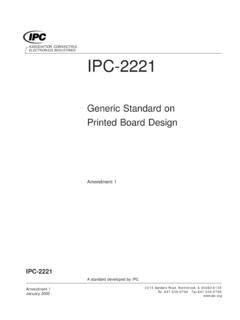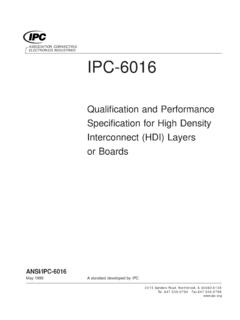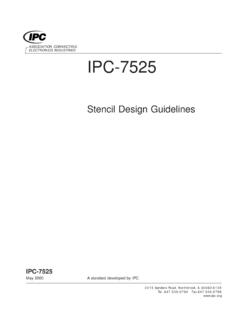Transcription of Specification for Base Materials for Rigid and …
1 IPC-4101 BSpecification for BaseMaterials for Rigid andMultilayer printed BoardsProposed Standard for BallotASSOCIATION CONNECTINGELECTRONICS INDUSTRIES 3000 Lakeside Drive, Suite 309S, Bannockburn, IL 60015-1219 Tel. Fax 2006A standard developed by IPCS upersedes IPC-4101 Awith Amendment 1 June 2002 The Principles ofStandardizationIn May 1995 the IPC s Technical Activities Executive Committee (TAEC) adopted Principles ofStandardization as a guiding principle of IPC s standardization Should: Show relationship to Design for Manufacturability(DFM) and Design for the Environment (DFE) Minimize time to market Contain simple (simplified) language Just include spec information Focus on end product performance Include a feedback system on use andproblems for future improvementStandards Should Not.
2 Inhibit innovation Increase time-to-market Keep people out Increase cycle time Tell you how to make something Contain anything that cannotbe defended with dataNoticeIPC Standards and Publications are designed to serve the public interest through eliminating mis-understandings between manufacturers and purchasers, facilitating interchangeability and improve-ment of products, and assisting the purchaser in selecting and obtaining with minimum delay theproper product for his particular need. Existence of such Standards and Publications shall not inany respect preclude any member or nonmember of IPC from manufacturing or selling productsnot conforming to such Standards and Publication, nor shall the existence of such Standards andPublications preclude their voluntary use by those other than IPC members, whether the standardis to be used either domestically or Standards and Publications are adopted by IPC without regard to whether their adop-tion may involve patents on articles, Materials , or processes.
3 By such action, IPC does not assumeany liability to any patent owner, nor do they assume any obligation whatever to parties adoptingthe Recommended Standard or Publication. Users are also wholly responsible for protecting them-selves against all claims of liabilities for patent PositionStatement onSpecificationRevision ChangeIt is the position of IPC s Technical Activities Executive Committee that the use and implementationof IPC publications is voluntary and is part of a relationship entered into by customer and an IPC publication is updated and a new revision is published, it is the opinion of the TAEC that the use of the new revision as part of an existing relationship is not automatic unless requiredby the contract.
4 The TAEC recommends the use of the latest October 6, 1998 Why is therea charge forthis document?Your purchase of this document contributes to the ongoing development of new and updated industrystandards and publications. Standards allow manufacturers, customers, and suppliers to understandone another better. Standards allow manufacturers greater efficiencies when they can set up theirprocesses to meet industry standards, allowing them to offer their customers lower spends hundreds of thousands of dollars annually to support IPC s volunteers in the standardsand publications development process.
5 There are many rounds of drafts sent out for review andthe committees spend hundreds of hours in review and development. IPC s staff attends and par-ticipates in committee activities, typesets and circulates document drafts, and follows all necessaryprocedures to qualify for ANSI s membership dues have been kept low to allow as many companies as possible to , the standards and publications revenue is necessary to complement dues revenue. Theprice schedule offers a 50% discount to IPC members. If your company buys IPC standards andpublications, why not take advantage of this and the many other benefits of IPC membership aswell?
6 For more information on membership in IPC, please visit or call 847 you for your continued support. Copyright 2006. IPC, Bannockburn, Illinois. All rights reserved under both international and Pan-American copyright copying,scanning or other reproduction of these Materials without the prior written consent of the copyright holder is strictly prohibited and constitutesinfringement under the Copyright Law of the United for BaseMaterials for Rigid andMultilayer printed BoardsDeveloped by the Laminate/Prepreg Materials Subcommittee (3-11) ofthe printed board base Materials Committee (3-10) of IPCU sers of this publication are encouraged to participate in thedevelopment of future.
7 IPC3000 Lakeside Drive, Suite 309 SBannockburn, Illinois60015-1219 Tel 847 847 :IPC-4101A withAmendment 1 - June 2002 IPC-4101A - December 2001 IPC-4101 - December 1997 IPC-L-108 IPC-L-109 IPC-L-112 IPC-L-115 IPC-AM-361 association CONNECTINGELECTRONICS INDUSTRIES Specification for base Materials forRigid and multilayer printed Boards1 SCOPEThis specification covers the requirements for base materi-als, herein referred to as laminate or prepreg, to be usedprimarily for Rigid or multilayer printed boards for electri-cal and electronic ClassificationThe system shown below identifiesclad and unclad laminate or prepreg base Materials .
8 Thespecification sheets serve as a cross-reference connectingthe outlined callout system in this document to previouslyused for laminate base Materials where this specifica-tion is referenced:LMaterial Designator (see )25 Specification Sheet Number (see )1500 Nominal Laminate Thickness (see )C1/C1 Metal Cladding Type and Nominal Weight/Thickness (see )AThickness Tolerance Class (see )ASurface Quality Class (see )Example for prepreg base Materials where this specificationis referenced:PMaterial Designator (see )25 Specification Sheet Number (see )E7628 Reinforcement Style (see )TWResin Content Method (see )REFlow Parameter Method (see )VCOptional Prepreg Method (see ) Specification Sheet DescriptionAt the end of thisdocument is a series of specification sheets.
9 Each specifi-cation sheet outlines requirements for both laminate andprepreg for each product grade. The specification sheets areorganized by a specific reinforcement type, resin system,and/or construction and are provided with a specificationsheet number for ordering purposes. For convenience, thelaminate and prepreg requirements for Materials of the likecomposition are on the same specification sheet. MaterialDesignator L indicates laminate material and MaterialDesignator P indicates prepreg material as shown in des-ignation examples in When certifying to multiplespecification sheets, the strongest performance headings for each specification sheet include referencedefinitions for the material , which cover the reinforce-ments, resin systems, flame retardants, and fillers used, aswell as its other known identifications and glass transitiontemperature, Tg.
10 The specific line items within the specifi-cation sheets are the requirements that materialshallmeetin order to be certified to this Nominal Laminate ThicknessThe nominal thick-ness is identified by four digits. For all substrates coveredby this document, thicknesses may be specified or mea-sured either over the cladding or over the dielectric ( and ). For metric specification, the first digitrepresents whole millimeters, the second represents tenthsof millimeters, etc. For orders requiring Imperial units, thefour digits indicate the thickness in ten-thousandths of aninch (tenths of mils).



